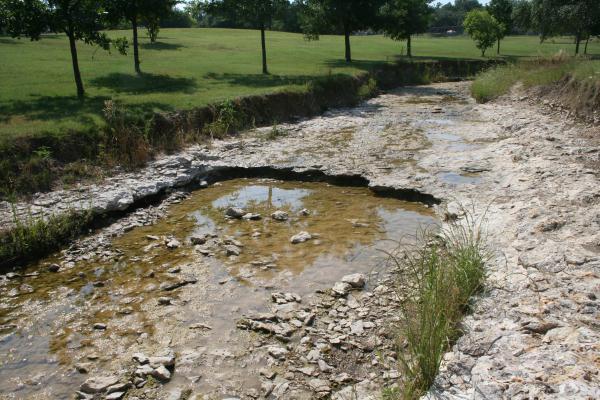
The learning objectives of this EarthCache are to identify a trace fossil and learn about the animal's behavior that may have created the fossil. Terrain rating is for wet and possibly slippery area near creek and uneven rock surface.
Kellis Park is one of 228 public parks in the city of Fort Worth. The park has a pool, a playground, and picnic tables, making it a great place to get away in the middle of Cow Town. This is a kid friendly cache!
If this area has received significant rain, it may be flooded temporarily.
Approximately 100 million years ago, during the Createceous Period, this area was beach front property for marine and other animals living here. The plants and animals who lived here have left evidence of their behavior for us to study and understand what life was like so many years ago.
Visitors to Kellis Park will notice an interesting pattern in the sandstone along the creek bed. Paleontologists describe these formations as trace fossils or ichnofossils. These formations are geological records of biological activity. Trace fossils are formed by animals performing the functions of their everyday life, such as walking, crawling, burrowing, boring, or feeding. Trace fossils contrast with body fossils, which are the fossilized remains of parts of animals' bodies, usually altered by later chemical activity or mineralization. Unlike most other fossils, which are produced only after the death of the animal or plant concerned, trace fossils provide us with a record of the activity of an animal or plant during its lifetime.
Trace fossils are important in paleontology and paleoecology because they provide information about the presence of unpreserved soft-bodied members of the original communities, life habits of fossil organisms, evolution of certain behavior patterns through geologic time, and more. Trace fossils also are useful in sedimentology and paleoenvironmental studies, because they are sedimentary structures that are preserved in place and are very rarely reworked and transported, as body fossils of animals and plants commonly are. This fact allows trace fossils to be regarded as reliable indicators of original conditions in the sedimentary environment.
Trace fossils are generally difficult or impossible to assign to a specific animal. Only in very rare occasions, the animal is found in association with their tracks. Further, entirely different animals may produce identical tracks. Therefore conventional system for naming fossils is not applicable, and so a different system was created to name trace fossils. At the highest level of the classification, five behavioral modes are recognized by paleontologists:
Domichnia, dwelling structures reflecting the life position of the animal that created it.
Fodinichnia, three-dimensional structures left by animals which eat their way through sediment;
Pascichnia, feeding traces left by grazers on the surface of a soft sediment or a mineral substrate;
Cubichnia, resting traces, in the form of an impression left by an animal on a soft sediment;
Repichnia, surface traces of creeping and crawling.
Logging Requirements: In an email to the cache owner, send your answer to the question below. (Do not post answer in your log or it will be deleted.) As an aspiring palenontologist, send your observations about the trace fossils you discovered in Kellis Park near the posted coordinates. Based on the definitions given above, which behavioral mode best describes the trace fossils you found in Kellis Park? Explain why.
Please take photograhs that add to the story of your visit to Kellis Park. This not a requirement, but is appreciated!
Special thanks to the Dallas Paleontological Society for their assistance with this project.
